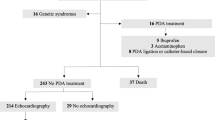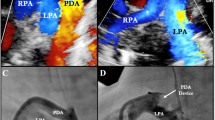Abstract
Objective:
Identify echocardiographic parameters at ⩽4 day postnatal that predict the subsequent need for closure of a clinically significant patent ductus arteriosus (sPDA) in extremely-low-birth-weight neonates (ELBW).
Study Design:
Serial echocardiograms obtained in 115 ELBW at ⩽10 day postnatal were examined to estimate PDA size using the PDA:left pulmonary artery (LPA) diameter ratio: ⩾1 indicated a large PDA, <1 but ⩾0.5 moderate, and <0.5 small. Sensitivity, specificity, and positive predictive values (PPV) were determined for ELBW <27 weeks and ⩾27 weeks gestational age.
Result:
Neonates with moderate to large PDA at ⩽4 day had 15-times greater likelihood of requiring treatment for sPDA than those with a small PDA (95% confidence interval (CI): 5.6–41). Sensitivity, specificity and PPV of the PDA:LPA at <27 weeks was 80, 86 and 92%, respectively.
Conclusion:
A moderate to large PDA determined from the PDA:LPA ratio at ⩽4 day postnatal identifies neonates <27 week gestation who subsequently require closure of a PDA.
This is a preview of subscription content, access via your institution
Access options
Subscribe to this journal
Receive 12 print issues and online access
$259.00 per year
only $21.58 per issue
Buy this article
- Purchase on Springer Link
- Instant access to full article PDF
Prices may be subject to local taxes which are calculated during checkout
Similar content being viewed by others
References
Yu VY . Patent ductus arteriosus in the preterm infant. Early Hum Dev 1999; 35: 1–14.
Furzan JA, Reisch J, Tyson JE, Laird P, Rosenfeld CR . Incidence and risk factors for symptomatic patent ductus arteriosus among inborn very-low-birth-weight infants. Early Hum Dev 1985; 12: 39–48.
Mouzinho AI, Rosenfeld CR, Risser R . Symptomatic patent ductus arteriosus in very-low-birth-weight infants: 1987–1989. Early Hum Dev 1991; 27: 65–77.
Ellison RC, Peckham GJ, Lan P, Talner NS, Lerer TJ, Lin L et al. Evaluation of the preterm infant for patent ductus arteriosus. Pediatrics 1983; 71: 364–372.
Quinn D, Cooper B, Clyman RI . Factors associated with permanent closure of the ductus arteriosus: a role for prolonged indomethacin therapy. Pediatrics 2002; 110: e10.
Reller MD, Lorenz JM, Kotagal UR, Meyer RA, Kaplan S . Hemodynamically significant PDA: an echocardiographic and clinical assessment of incidence, natural history, and outcome in very low birth weight infants maintained in negative fluid balance. Pediatr Cardiol 1985; 6: 17–23.
Cotton RB, Lindstrom DP, Stahlman MT . Early prediction of symptomatic patent ductus arteriosus from perinatal risk factors: a discriminant analysis model. Acta Paediatr Scand 1981; 70: 723–727.
Hermes-DeSantis ER, Clyman RI . Patent ductus arteriosus: pathophysiology and management. J Perinatol 2006; 26: S14–S18.
Laughon ML, Simmons MA, Bose CL . Patency of the ductus arteriosus in the premature infant: is it pathologic? Should it be treated? Curr Opin Pediatr 2004; 16: 146–151.
Koch J, Hensley G, Roy L, Brown S, Ramaciotti C, Rosenfeld CR . Prevalence of spontaneous closure of the ductus arteriosus in neonates at a birth weight of 1000 grams or less. Pediatrics 2006; 117: 1113–1121.
Schmidt B, Davis P, Moddemann D, Ohlsson A, Roberts RS, Saigal S et al. Long-term effects of indomethacin prophylaxis in extremely-low-birth-weight infants. N Eng J Med 2001; 344: 1966–1972.
Schmidt B, Roberts RS, Fanaroff A, Davis P, Kirpalani HM, Nwaesei C, et al., TIPP Investigators. Indomethacin prophylaxis, patent ductus arteriosus, and the risk of bronchopulmonary dysplasia: further analyses from the Trial of Indomethacin Prophylaxis in Preterms (TIPP). J Pediatr 2006; 148 (6): 730–734.
Koehne PS, Bein G, Alexi-Meskhishvili V, Weng Y, Bührer C, Obladen M . Patent ductus arteriosus in very low birthweight infants: complications of pharmacological and surgical treatment. J Perinat Med 2001; 29: 327–334.
Constantine NA, Kraemer HC, Kendall-Tackett KA, Bennett FC, Tyson JE, Gross RT . Use of physical and neurologic observations in assessment of gestational age in low birth weight infants. J Pediatr 1987; 110: 921–928.
Jimenez JM, Tyson JE, Reisch JS . Clinical measures of gestational age in normal pregnancies. Obstet Gynecol 1983; 61: 438–443.
Cotton RB, Stahlman MT, Catterton WZ . Medical management of small preterm infants with symptomatic patent ductus arteriosus. J Pediatr 1978; 92: 467–473.
Lang RM, Bierig M, Devereux RB, Flachskampf FA, Foster E, Pellikka PA, et al., Chamber Quantification Writing Group; American Society of Echocardiography's Guidelines and Standards Committee; European Association of Echocardiography. Recommendations for chamber quantification: a report from the American Society of Echocardiography's Guidelines and Standards Committee and the Chamber Quantification Writing Group, developed in conjunction with the European Association of Echocardiography, a branch of the European Society of Cardiology. J Am Soc Echocardiogr 2005; 18: 1440–1463.
Wald RM, Adatia I, Van Arsdell GS, Hornberger LK . Relation of limiting ductal patency to survival in neonatal Ebstein's anomaly. Am J Cardiol 2005; 96: 851–856.
Tshuppert S, Doell C, Arlettaz-Mieth R, Baenziger O, Roussson V, Balmer C et al. The effect of ductal diameter on surgical and medical closure of patent ductus arteriosus in preterm neonates: size matters. J Thorac Cardiovasc Surg 2008; 135: 78–82.
Author information
Authors and Affiliations
Corresponding author
Ethics declarations
Competing interests
The authors declare no conflict of interest.
Rights and permissions
About this article
Cite this article
Ramos, F., Rosenfeld, C., Roy, L. et al. Echocardiographic predictors of symptomatic patent ductus arteriosus in extremely-low-birth-weight preterm neonates. J Perinatol 30, 535–539 (2010). https://doi.org/10.1038/jp.2010.14
Received:
Revised:
Accepted:
Published:
Issue Date:
DOI: https://doi.org/10.1038/jp.2010.14
Keywords
This article is cited by
-
Oral versus intravenous paracetamol for patent ductus arteriosus closure in preterm infants
Pediatric Research (2022)
-
Factors associated with development of early and late pulmonary hypertension in preterm infants with bronchopulmonary dysplasia
Journal of Perinatology (2020)
-
Echocardiographic predictors of acute kidney injury in neonates with a patent ductus arteriosus
Journal of Perinatology (2020)
-
Early prediction of spontaneous Patent Ductus Arteriosus (PDA) closure and PDA-associated outcomes: a prospective cohort investigation
BMC Pediatrics (2019)
-
Patent ductus arteriosus in preterm infants: is early transcatheter closure a paradigm shift?
Journal of Perinatology (2019)



